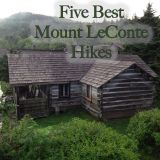All You Need to Know About Snakes in the Smoky Mountains
Yes, there are 23 species of snakes found in the Great Smoky Mountains National Park, but only 2 of them are poisonous; so don’t let that keep you from getting out and enjoying a walk in the woods this summer. Here’s all you need to know about snakes in the Smoky Mountains and how to stay safe in the great outdoors!
HeySmokies’ recent video on Facebook (see below) of a timber rattlesnake at Gregory Bald created quite a reaction from fans, so we thought some helpful tips were in order so that both snakes and humans can enjoy soaking up the summer sun without fear.
It’s true that one of us at HeySmokies has the unfounded fear that all snakes just lie waiting in the forest to ambush the passerby. Of course, nothing could be further from the truth! Generally, snakes are reclusive and elusive creatures rarely seen by park visitors; however, one of us at HeySmokies is still always asked to go first and be on “snake patrol.” All of this leads us to our first tip: Just use common sense. Be mindful of your surroundings and where you are placing your feet and your hands (and your bum if you have the calling!)
The Timber Rattlesnake, which has the most toxic venom of the two poisonous species, will often give you a loud warning with his rattle if you get too close. You may not hear this if you are hiking with your earbuds blasting out your favorite song. Keep children close and be mindful where they are stepping. When walking through the high grass on a mountain bald it can be hard to see where you are putting your feet; there may be other critters you can’t see enjoying the view too. Wear the proper footwear, it should be obvious that a bite on the foot while wearing flip-flops could be trouble so sturdy hiking boots are a plus. Snakes often lie in the warm leaf litter against fallen trees on the trail so be careful when stepping on and over downed trees.
If you are climbing on rocks be aware of where you are putting your hands. The warm, rocky outcrops are a favorite place for snakes to bask in the sun. While the Timber Rattler often gives a warning signal before striking, the other poisonous snake, the Northern Copperhead does not. Snakes are active both day and night during the summer season, so definitely use a flashlight after dark to make sure where you are stepping is critter-free.
The Northern Copperhead’s venom is less toxic than that of the Timber Rattlesnake and a bite is rarely fatal although extremely painful. Copperheads are commonly found on wooded hillsides and rock outcrops above streams or ponds. During the summer, snakes lie out in the sunlight during the day and hunt at night. Like the Timber Rattlesnake, the Northern Copperhead hunts small rodents, frogs, lizards, cicadas, and caterpillars. The young Copperheads “twitch” their tender yellow tipped tail to attract prey. Snakes are an important part of a healthy ecosystem.
There are a lot of old homes, buildings and stone walls in the Smokies, and all are a favorite habitat for snakes; so again, just be mindful when you go exploring. If you see a snake keep your distance and never attempt to handle it even if you are pretty sure what kind it is. Let’s give all snakes the healthy respect they are due and remember we are visitors in their home.
What to do if you get bitten by a snake
No fatalities from snakebites have ever been recorded in the park but a couple of visitors have been bitten in recent years. If you are bitten, the most important thing is to stay calm and call 911 even if you believe the snake is non-poisonous. One of the items in HeySmokies’ emergency kit is a black Sharpie so the bite area can be circled to ensure medical professionals will know exactly where the puncture wound is if the area begins to change color and swell. It is no longer recommended that you try to extract the venom yourself; it is more important to spend the time getting yourself to the hospital for modern, anti-venom drugs. While waiting for medical assistance, remain calm and position yourself, if possible, so that the bite is at or below the level of your heart. Remove any tight clothing and jewelry before swelling begins. Do not use a tourniquet or apply ice. If you have to hike out, then walk slowly and do not exert yourself as this causes the venom to spread more quickly through the body. We hope it goes without saying, but don’t try to capture or kill the snake to bring it with you for identification. If someone in your party can snap a quick photo great, but if not try to remember its color and shape so you can describe it; remember your time is better spent seeking immediate medical attention.
Here’s the HeySmokies video of this marvelous creature we met at Gregory Bald while enjoying the native azaleas!












